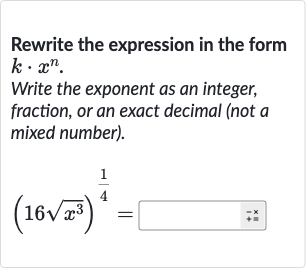AI tutor
Welcome to Bytelearn!
Let’s check out your problem:

Rewrite the expression in the form .Write the exponent as an integer, fraction, or an exact decimal (not a mixed number).
Full solution
Q. Rewrite the expression in the form .Write the exponent as an integer, fraction, or an exact decimal (not a mixed number).
- Simplify inside the parentheses: First, let's simplify the expression inside the parentheses before applying the outer exponent. The expression inside the parentheses is . The square root of can be written as .
- Rewrite expression without radicals: Now, we can rewrite the expression as . Since there are no square roots or other radicals left inside the parentheses, we can now apply the outer exponent of to both the constant and the variable.
- Apply exponent to constant and variable: Applying the exponent of to , we get . The fourth root of is , because .
- Calculate exponent of constant: Applying the exponent of to , we use the rule of exponents that states . So, .
- Combine results for final expression: Combining the results from the previous steps, we get the final expression in the form , which is .


